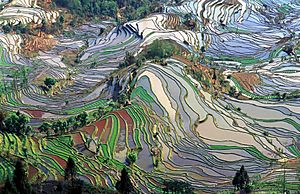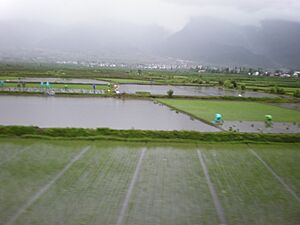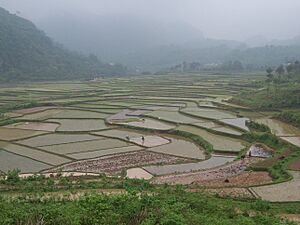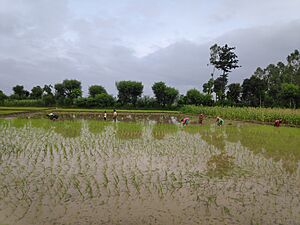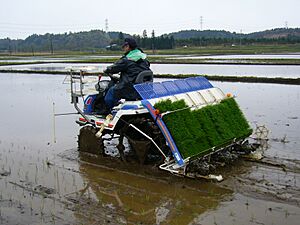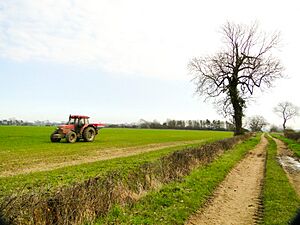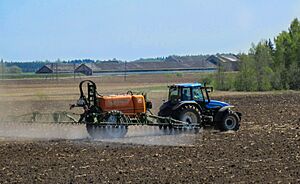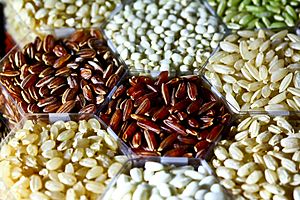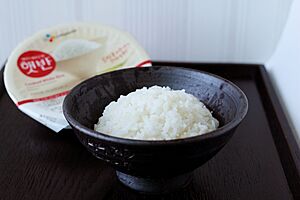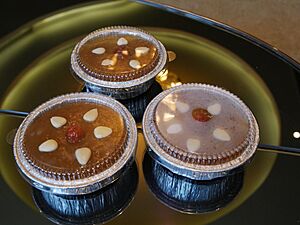Rice production in China facts for kids
Quick facts for kids Rice production in China |
|
|---|---|
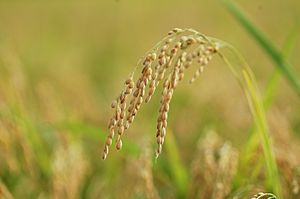
Japonica plant
|
|
| Product name | Rice |
| Source plant(s) | Oryza sativa, mostly O. s. cv. japonica |
| Part(s) of plant | Seed |
| Geographic origin | Yangtze River basin |
| Active ingredients | Possible wild gathering 10,000 years ago, domestication 7,500 years ago |
| Uses | Human main food |
| Main producers | Yunnan, Hunan, Heilongjiang, Jiangxi, Hubei, Anhui, Jiangsu |
Rice production in China is all about growing and harvesting rice for people to eat in mainland China.
China is the world's biggest rice producer, making about 30% of all the rice globally. It also grows the most rice per area in Asia. Rice is grown all over China. People think rice was first grown in the areas around the Yangtze River and the Yunnan-Guizhou Highlands in Southern China. Ancient records show that rice was first farmed around the Yangtze River Valley and Yellow River about 11,000 years ago. This happened in the middle of the Yangtze River, in the Hubei and Hunan provinces.
Chinese farmers use special ways to grow rice. They turn soil into mud to stop water from escaping. They also move young rice plants from one place to another, which is called transplanting.
The main types of rice grown in China are wild rice species like O. Mereriana, O. Officinalis, and O. Rufipogon. The most common cultivated types are indica and japonica. China is also working on growing new types of hybrid rice.
Indica and japonica rice are grown in different parts of China, and sometimes in the same areas. Hybrid rice is mostly grown in Central China.
China has many different areas where rice is grown. These areas have different climates, like warm, cold, or dry. They also have different growing times and soils. This is what makes each type of rice unique. The climate also decides when farmers plant and harvest rice in different regions.
Growing rice in China needs a lot of hard work. Farmers use different ways to plant and grow their crops. These methods change depending on the climate in each region. Common ways to plant rice include transplanting (moving young plants), manual transplanting (by hand), mechanical transplanting (with machines), throwing seeds, and direct seeding (planting seeds straight into the field). Farmers also use a method called rice ratooning, where new crops grow from the cut stems of the first crop.
In 2019, China exported about 4.56% of the world's rice, which was worth about US$1.13 billion. In 2020/2021, China was the sixth largest rice exporter in the world.
Rice farming in China faces some challenges. These include climate change, which causes more natural disasters like floods. Farmers also use too much fertilizer, which makes the land less fertile. And using too many pesticides can harm biodiversity and lead to more pest problems.
The future of rice farming in China involves using special rice seeds (called elite germplasm) and different types of rice (genetic diversity). There are also "super rice" breeding programs to help rice plants deal with current problems. Farmers are also looking for ways to use less water when growing rice.
Rice is a very important food in China. It's the main food for two-thirds of the country's people. Rice comes in many flavors, textures, and grain types. Each one is special and can be made into different foods. Some popular rice dishes include cooked rice, rice porridge, and fried rice. Rice can also be ground into flour to make noodles. Sticky rice is another type of rice used in many dishes, desserts, and even drinks.
Contents
History of Rice in China
How Wild Rice Became Farmed
China is one of the most important places where rice was first grown and became a farmed crop. People believe wild rice was first found in Southern China, especially around the Yangtze River and the Yunnan-Guizhou highlands. These areas are home to many different types of wild rice. Over time, these wild rice types changed and became the O. Sativa subspecies, japonica and indica, that we eat today.
Archaeologists have found old rice remains around the Yangtze River Valley and the Yellow River. This suggests that rice was first farmed there around 7000 BC. Some very old rice remains, about 11,000 years old, were found in the middle of the Yangtze River in Hubei and Hunan provinces. This shows that rice farming started there and then spread to other areas.
Farmers learned to grow rice by noticing how wild rice changed. For example, farmed rice lost its color and didn't scatter its seeds as easily. Early farmers used fire, bones, and wooden tools to clear wet areas and create rice paddy fields.
Growing Rice for Thousands of Years
Rice has been grown in China for over 10,000 years! Ancient texts mention rice from as far back as the Xia dynasty (21st century BC). In old times, japonica rice was called Jing or Keng, indica rice was called Xian or Hsien, and glutinous rice was called Nuodao.
Archaeological finds show that rice was first grown in the middle of the Yangtze River in central China. Researchers found rice grains and plant remains from many sites along the 6,300-kilometer Yangtze River. The oldest samples were about 11,000 years old. This suggests that rice farming started in this central area and then moved to other regions.
Old Planting Techniques Still Used Today
Farmers in China developed techniques like turning soil into mud to stop water from escaping. They also started transplanting young rice plants. These methods helped turn wild rice into the farmed phuddi and indica types. These techniques are still used in China today.
Types of Rice in China
Wild Rice Species
There are three types of wild rice in China: O. mereriana, O. officinalis, and O. rufipogon. O. rufipogon is the most common and grows across China and in Taiwan. Wild rice is often found in wet marshlands, hills, and low grasslands. Sadly, due to more human activity, the amount of O. rufipogon in China has dropped by 70% since the 1950s.
Farmed Rice Varieties
The types of rice that are farmed today are thought to have come from areas near the Yangtze and Huai rivers. Over time, wild rice varieties changed and were grown by farmers. They became the O. sativa subspecies, japonica and indica.
Improving Rice Through Breeding
Scientists use hybrid rice breeding to grow rice that produces more and can handle tough environments. This started in the 1970s with Yuan Longping. In 1996, the Ministry of Agriculture started the Super Rice Project, mixing japonica and indica types. However, this process takes a lot of time.
Japonica Rice
Japonica plants are small with dark green leaves. Their grains are round and short and don't break easily. When cooked, they are moist and sticky because they have a lot of a substance called amylopectin. Japonica rice grows well in cool climates.
Indica Rice
Indica plants are tall with light green leaves. Their grains can be short or long, narrow, and flat, and they can break easily. When cooked, they are flakier and drier than japonica rice because they have less amylopectin.
Where Different Rice Types Grow
- Japonica rice is mostly grown in Regions 2, 3, 5, and 6.
- Indica rice is mostly grown in Regions 1, 2, 3, and 4.
- Hybrid types of Indica rice are grown in Region 2.
Rice Growing Areas
Main Growing Regions
Region 1: Southern China This warm, subtropical region includes parts of Guizhou, Guangdong, Guangxi, Fujian, Hainan provinces, and Taiwan. It mostly grows indica rice.
Region 2: Central China This is the biggest rice-producing area. It stretches from the Chengdu Plains to the eastern coast. It includes parts of Hubei, Hunan, Jiangxi, Anhui, Zhejiang, Jiangsu provinces, and areas around Chongqing and Shanghai. This subtropical region grows Indica, hybrid indica, and japonica rice.
Region 3: Southwestern plateau This subtropical region includes parts of Tibet, Sichuan, Qinghai, Yunnan, Guangxi, Hunan, and Guizhou provinces. It mainly grows japonica and indica rice.
Region 4: Northern China This subtropical region includes Beijing, Shandong, Tianjin, and parts of other provinces. It mostly grows indica rice.
Region 5: Northeastern China This region, including Jilin and Heilongjiang, has the coldest climate. Temperatures are usually between 2 to 10°C. It mainly grows indica rice.
Region 6: Northwestern China This is the driest region, including Ningxia and Xinjiang. It mostly grows japonica rice.
Climate and Growing Seasons
The climate in China's rice regions affects how rice grows.
- Subtropical areas are humid and warm, with long growing periods. The soil types include brown, red, yellow, and alluvial soils.
- Cold areas have fertile soils but crops can be damaged by frost.
- Dry areas have little rain, so soils are less fertile and farms rely on irrigation from rivers.
Rice is planted and harvested at different times across China. Early rice crops are planted from February to April and harvested in June and July. Intermediate and single-crop late rice is planted from March to June and harvested in October and November. Double-crop late rice is harvested in October to November. Rice grown in the north is planted from April to June and harvested from September to October. As the climate gets warmer, rice can now be grown further north.
How Rice is Produced
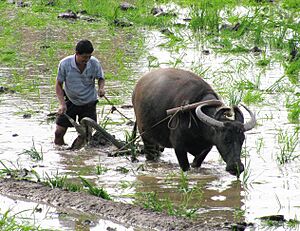
Growing Systems
The way rice is grown changes across China due to different climates.
- Single rice cropping is common in the North, making up 17% of China's rice.
- Double rice cropping is mostly used in the South, making up 34%.
- Rice-upland crop rotation (growing rice and other crops) is used in Central regions and near the Yangtze River. This system produces 49% of the nation's rice.
Planting Methods
Farmers use different planting methods depending on the area. Common methods include manual, throwing, mechanical, direct seeding, and ratooning rice.
- Manual transplanting (by hand) is less common now because there are fewer skilled workers. It's used in smaller fields with many available workers.
- Direct-seeded rice (planting seeds directly into the field) has grown since the 1990s.
- Transplanting is the most common method. Young rice plants are grown in a nursery, then moved to muddy fields after 15 to 20 days. This helps get higher yields and less weeds.
- Mechanical transplantation uses machines to move young rice plants.
- Direct seeding means sowing rice seeds right into the fields, either by hand or machine. Both mechanical transplanting and direct seeding save time and labor.
- Throwing seedlings is another method that saves labor. It can also help get high yields with less fertilizer.
- Rice ratooning means growing new crops from the cut stems of the first crop. This saves water and can increase farmers' profits.
Rice Quality
The quality of rice depends on many things, like the type of rice, how it's grown, and how it's processed. Good quality rice is important for China's rice industry.
Rice quality is judged by its processing, look, how it feels when eaten, and its nutrients. The natural environment, like soil and weather, also affects quality. For example, high temperatures during the grain-filling stage can make grains chalky, which is not good for their look or how they mill.
Different planting methods and regions also affect rice quality because they have different temperatures and light during rice growth. Using more potassium fertilizer can improve rice quality and make it less chalky, but too much can be bad for people.
Changes in Planting Areas
Over the years, some areas in China have grown more rice, while others have grown less. Northeast provinces like Jilin and Heilongjiang have increased rice production. But in areas like Guangdong and Fujian, which are becoming more urban, rice production has decreased. This is because more farmers are moving to cities for jobs. Also, challenges like climate change and too much fertilizer and pesticides have affected production. Because of this, the main rice-growing areas have shifted to the northeast.
Rice Exports
In 2019, China exported 4.56% of the world's rice, worth about US$1.13 billion. In 2020/2021, China was the sixth largest rice exporter globally.
Between November 2020 and November 2021, China exported $75 million worth of rice and imported $202 million. This meant China imported more rice than it exported during that time.
In November 2021, China mostly exported rice to Turkey, South Korea, Vietnam, Cameroon, and Puerto Rico. It mostly imported rice from Thailand, Vietnam, Pakistan, India, and Myanmar.
Challenges for Rice Farming
Climate Change Effects
Rice is a main food for most people in the world, and China is no exception. China's rice production has grown a lot, mostly because of better yields, not more land. But in recent years, rice yields haven't increased as much. Experts think this is because of climate change.
Climate change causes problems for rice farming in China. Daily temperatures for all types of rice have increased by 0.8 to 4.1°C. This has changed when farmers plant rice. For example, early rice crops should be planted earlier, and late rice crops should be planted later. This helps the rice grow better.
Climate change also brings more natural disasters like floods and droughts. These stop rice from growing well and lead to smaller harvests. In 2003, Hubei province lost a lot of rice crops due to heat stress. Rice grains become empty if temperatures go over 35°C.
Too Much Fertilizer
Farmers in China sometimes use too much fertilizer to protect their crops from climate change risks. They might also not know enough about how much fertilizer to use, or they might follow old traditions.
China uses 30% of the world's nitrogen fertilizers, with 7% used for rice. Even with all this use, China's rice yields are sometimes lower than other countries. Only about 20-30% of the fertilizer is absorbed by the plant. The rest pollutes the environment and makes the soil less fertile.
Using too much fertilizer can harm the land, pollute water, and make it harder to grow rice sustainably.
Too Many Pesticides
China is the world's largest producer and user of rice, and it uses the most pesticides on its rice crops compared to other crops like corn or wheat. Pesticides are used to stop pests, weeds, and diseases. Chinese rice farmers often spray their crops weekly to prevent damage.
Farmers use a lot of pesticides to increase their income and ensure food safety. They might also lack knowledge about pest management or get wrong information. Pesticides are important for growing enough food for the world's population.
China is the largest maker and user of pesticides globally. The amount of chemical pesticides used per area in China is 2.5 to 5 times higher than in developed countries. While pesticides help farmers, too much use can harm people, animals, and the environment. Chemicals can pollute soil, water, and plants. Researchers say that each year, over 10 million mu (a Chinese land measure) of crops are polluted by pesticides. Only about 30% of pesticides are used by the plants; the other 70% goes into the environment.
Too many pesticides can also kill helpful insects and lead to pests becoming resistant to the chemicals. This can cause more pest outbreaks. Farmers have also reported health problems, like issues with their nervous, digestive, and respiratory systems, which can lead to long-term illnesses.
The Future of Chinese Rice Production
Better Rice Types and Breeding Programs
Scientists are creating special new rice types, like the indica-japonica hybrid. They are studying genes to make new varieties that can handle drought and grow well. The "super rice" breeding program aims to produce high-quality rice that can survive tough conditions.
Smart Farming Systems
New farming systems and databases are being developed to help manage fertilizer, water, and pests. They can also help predict how much rice will be harvested.
Using Less Water
Scientists are studying aerobic rice, which needs less water because it can grow in high places. They want to develop types that can grow in dry conditions, especially in Northern and Central China where water for irrigation is limited.
How Rice is Eaten in China
Since so much rice is grown in China, it's a main food for two-thirds of the country. In 2020/2021, over 149 million metric tons were eaten. On average, each person ate about 76.8 kilograms of milled rice per year. However, rice consumption has slightly decreased over the years.
Rice grains come in many flavors, textures, and types, each with its own special qualities. These differences come from where the rice is grown. Processed rice grains are full of nutrients, vitamins, and healthy minerals, making them a great source of complex carbohydrates.
Rice is prepared and eaten in many ways:
Cooked Rice Dishes
Milled rice is cooked with water by boiling, steaming, or braising. You can add vegetables, meat, fish, and beans to flavor it. Rice porridge is a popular dish for people who are sick or for children because it's easy to digest.
Fried rice is a very common Chinese dish made from cooked rice. It can be sweet or savory.
Rice Noodles
Rice can be ground into rice flour, which is used to make many dishes. Rice flour can be mixed with water to make a dough, then cut or pulled into long strands to make noodles.
These noodles can be dried, fried, boiled, or frozen, and used in various Chinese meals.
Sticky Rice Treats
Glutinous rice, also known as sticky rice, is a popular type of rice. It's sweet and has a waxy, sticky texture when cooked. It's grown in Southeast and East Asia and can be short, medium, or long-grained.
Sticky rice can be fermented to make rice wine. It's also used to make Jiuniang, a sweet fermented rice that adds flavor to many Chinese dishes. Milled rice can also be ground to make rice noodles, dumplings like Tangyuan, Zongzi, and Yuanxiao, sticky rice cakes like Niangao, puddings, crackers, and bread.
Alcoholic Drinks from Rice
Rice is used to make alcoholic drinks like rice wine, such as Jiafan and Nuerhong. Sweet rice wines are often homemade.
Rice wine is also used a lot in Chinese cooking to add flavor to dishes or as a marinade. It can also be used to make vinegar.
Rice Bran
Rice bran is what's left over when brown rice is polished to become white rice. It's the outer layer of the rice grain. Rice bran is very nutritious, full of energy, protein, vitamins, minerals, oil, and fiber. It's also used for health benefits, like helping with diabetes, high blood pressure, and high cholesterol. It can also help prevent some cancers and strengthen the immune system.


